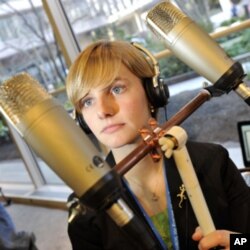A 17 year old from Fort Gratiot, Michigan, won this year’s Intel Science Talent Search, the oldest and most prestigious science competition for high school students in the United States.
“It’s a great honor and it pushes me to do the things I’ve been doing, that I love to do in my research work in science, my passion for science,” Nithin Tumma said.
Tumma won the $100,000 prize for research that could lead to more direct, targeted, effective and less debilitating breast cancer treatments.
During the week-long competition in Washington, D.C., he and his peers defended their work before judges and shared it with the public. President Obama applauded their achievements during a special meeting at the White House.
The president was not their only audience in Washington.
Wendy Hawkins, executive director of the Intel Foundation, which sponsors the event, said it puts a spotlight on science, technology, engineering and mathematics (STEM) education for legislators in Congress.
President Barack Obama welcomes the Intel finalists to the White House. (Courtesy: Intel)
“We want to influence the influencers, the decision-makers, the people who decide where the money flows to make sure that they understand how critical STEM education is for our future and for these students’ future,” Hawkins said.
The projects entered in the Intel competition contribute serious new scientific data and analysis. Jack Li, 18, from El Segundo, California, developed a new way to deliver an enzyme therapy for phenylketonuria (PKU), a genetic disease that causes mental retardation and seizures.
With the help of mentors at the University of California, Los Angeles, Li designed a microscopic capsule that seals and protects the therapeutic enzyme as it passes through the digestive system.
“The results were really wonderful," Li said. "The encapsulated version of the enzyme passed through the stomach and the small intestine unscathed, while the unencapsulated version was completely deactivated.”
A drug company has expressed interest in possibly taking Li’s project toward commercial development.
Another finalist, Marian Bechtel, 17, from Lancaster, Pennsylvania, engineered a new system for detecting buried landmines, an urgent problem in war zones worldwide.
“They actually kill or injure someone every 22 minutes.” That’s why, she said, “I looked into seismo-acoustics, which is just a fancy word for using sound waves and ground vibrations at the same time.”
Bechtel’s device is able to scan a field until it finds a resonating sound wave that identifies an object as a likely buried mine and not a rock or other debris.
“My statistical tests showed some really impressive results. It turns out that the method is actually very effective," Bechtel said. "I have yet to do blind testing and there are still a lot of improvements I want to make before I send it out somewhere. So far it’s showing a lot of potential.”
Bechtel hopes to publish her work before she heads off to college in a few months.
While neither Bechtel nor Li won the $100,000 top Intel prize, both were awarded $7,500.
But Li said it’s not about the money, it’s about the science.
“I think the role for us as the next generation of America’s leaders is we need to provoke interest in science among our peers. We need to go out and say, ‘Science is cool. Science is something that is awesome and you should get interested in it.’”
Bechtel agreed, calling science her addiction. “Once you get through it and have those breakthroughs. It’s so amazing. It’s such an amazing feeling. You just keep going back to it. I don’t think that I’ll ever be able to break that addiction to science.”
The Intel Science Talent Search confirmed that an “addiction to science” can be a good thing - and that it is driving a new generation of innovators who are helping to address some of the world’s most pressing challenges.












